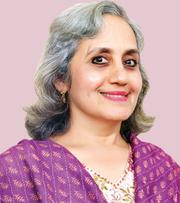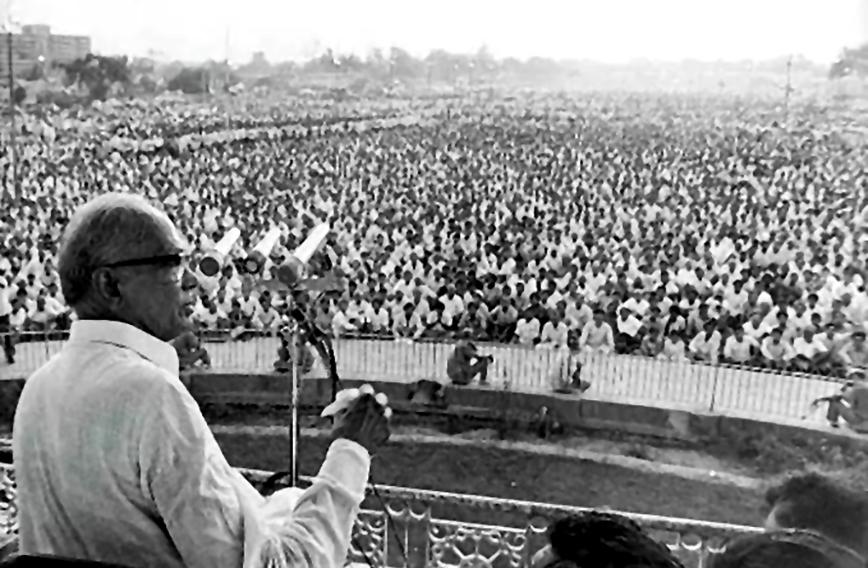
RAJNI BAKSHI
AN impassioned procession of protesters was marching towards Gandhi Maidan in Patna. The year was 1974 and that procession was part of the Bihar Movement led by the Gandhian veteran, Jayaprakash Narayan (JP). This was a movement against corruption and for deepening of democracy.
Suddenly, there was gun fire from the window of premises occupied by an MLA who presumably opposed the protesters. Amarnathbhai, a full-time worker of the Sarvodaya movement, was present. Here is how he recalls what happened next.
The gun fire caused an upsurge of anger among the protesters. Fortunately, JP was not walking in the procession at that precise moment. But the protesters understood that the gun shots were an attempt to kill their leader. Plus, some of them had been injured. It was in this mood of rage on a fragile leash that the procession entered Gandhi Maidan. The historic Maidan, in the heart of Patna, spreads across 60 acres and was packed to capacity. Even the roads around the Maidan were packed with surging crowds.
Amarnathbhai recalls that some of the protesters did shout slogans calling for violence. Such as: ‘Khoon ka badla khoon’ (‘Blood for blood’). When JP reached the Maidan he was handed a note from the District Magistrate (DM). In the note the DM pleaded that JP alone could save the day. Patna is now in your hands, the administrator wrote, the police will not be able to control the situation.
This was the context in which JP went on the dais and asked all those gathered to raise their hands and pledge that no matter who was responsible for the gun fire, they would not respond in kind. And then he invoked the slogan that was to become the rallying call of the JP movement: ‘Hamla chahe jaisa hoga, haath hamara nahin uthega’.
Amarnathbhai recalls how the slogan reverberated through the multitude, inspiring and being absorbed. The slogan may have been used before but many participants in the JP movement recall that tension-filled day at Gandhi Maidan as the occasion when the slogan took on a life of its own.
This month, June 2023, many people who identify with the JP movement are marking its 50th anniversary. For them and many others, the pledge to remain committed to non-violence is not merely a historical memory, it is a lived and practised commitment. For example, the Narmada Bachao Andolan in the early 1990s embodied this ethos as those resisting the submergence of their homes and lands protested against the construction of multiple dams on the Narmada river.
However, both the slogan and the ideal it represents have also been ridiculed and rejected. This has been done not just by the extreme Left and Right of the political spectrum. Mao Zedong’s infamous claim that political power grows out of the barrel of a gun has left its mark even on those who don’t follow him or call themselves communists.
So why does JP’s rallying call still ring true? Why does it seem appealing even to those who have doubts about making it practicable?
One, because most human beings know at an instinctive level that retaliatory anger usually produces unfortunate results. By comparison, self-restraint in a crucial moment of anger, or provocation to violence, becomes a powerful inner strength that can work wonders.
Two, as political philosopher Hannah Arendt has so precisely said, it is not power but merely obedience that flows from the barrel of a gun. True political power involves participation and engagement, not fear-driven obedience.
Three, the more commonly this ideal is neglected the greater the significance of every tiny way in which it is practised or reaffirmed in principle.
An incident at a polling booth in the 1989 Lok Sabha elections may serve as an illustration. Veteran socialist activist Vijay Pratap was on duty at a booth as part of Rajmohan Gandhi’s team. The latter was contesting the Rae Bareli Lok Sabha seat as the combined opposition candidate, challenging the sitting MP and then prime minister, Rajiv Gandhi.
At one point there was an altercation and some of the Congress party workers began beating one of Pratap’s colleagues. The man fell to the ground. Acting out of a combination of instinct and training, Pratap flung himself protectively on top of the fallen man, simultaneously shouting out: ‘Hamla chahe jaisa hoga, haath hamara nahin uthega’. Years later, Pratap recalled that those doing the beating seemed so stunned by this form of resistance that they stopped.
The annals of non-violent political action from across the world are filled with accounts of this kind. Of course, not everyone on this path lives to tell their tale. But the death toll seems to be much higher among those who choose the gun as their companion in political action.
A piece of insight from Prof. Anil Gupta’s Ahimsa Conversation might help to locate this striving in our immediate context. Gupta taught at IIM Ahmedabad for over three and a half decades and has a nuanced understanding of everyday life in India since he has traversed much of the country on foot during his scores of Shodh Yatras.
Yes, violence has increased in the past few decades, says Gupta. But if we focus only on this dark dimension, then we will not be able to find within ourselves the strength, courage and confidence to see that there is also still goodness and compassion in our society and that we can build upon that to rejuvenate our samaj.
The 50th anniversary of the JP movement is worth celebrating not merely for the impact it once had on the Indian polity but because its rallying call inspires us to cultivate inner strength and staying power to challenge not just violence but cynicism.
The History for Peace project’s 2023 conference from August 3-5 in Kolkata, is on the theme “The Idea of Justice” (www.historyforpeace.pw).Rajni Bakshi is the founder of YouTube channel Ahimsa Conversations
Comments
-

Neelam Deo - Aug. 1, 2023, 10:50 a.m.
What a gentle and simultaneously powerful commentary




